by David M. Smith and Stephen A. Woodbury
"Introduction
The health of the entry-level or low-wage labor market is central to the success of efforts to move welfare recipients into employment. With the unemployment rate near its lowest level in 30 years, the labor market currently appears to be relatively favorable to welfare-to-work efforts. However, there are reasonable concerns that when the next recession hits, many low-skilled jobs will vanish and the gains achieved by former welfare recipients who have made the transition to work will disappear.
This paper addresses four questions that concern low-wage labor markets and the prospects of former welfare recipients. First, how has the labor market for low-skilled workers fluctuated over the last business cycle? The unemployment, employment, and labor force participation of workers with different levels of education during the last decade are addressed in the first section.
Second, what happened to the number of low-wage and near low-wage jobs over the last business cycle, and what is the occupational mix of low-wage and near low-wage jobs? These questions are addressed in the second section.
Third, are there differences across regions of the U.S. in the health of the labor market and, in particular, in employment prospects of former welfare recipients? These questions are addressed in the third section.
Fourth, are there differences among central cities, suburbs, and nonurban areas in the health of the labor market and the employment prospects of former welfare recipients? These questions are addressed in the fourth section.
Although much has been written on the low-wage labor market in relation to minimum wage laws, there is a notable dearth of literature addressing the health of the low-wage labor market over the business cycle, and especially the question of how former welfare recipients might fare. The likely reason is that, until relatively recently, little serious consideration was given to the idea of moving welfare recipients into the labor market. The general view was that most welfare recipients are relatively low-skilled women with young children whose time is better spent in child care activities than in the formal labor market. Of course, this may be a correct view, but policy has moved in another direction.
The paper relies on tabulations of the Current Population Survey (CPS) from 1988, 1992, and 1997 (see the appendix for a discussion of our use of the data). These three years were chosen to reflect the state of the labor market near the peak of the last economic expansion (1988), at the trough of the last recession (1992), and at a point well into the current economic expansion (1997). In other words, these three years, at roughly four-year intervals, correspond to good times, recession, and (again) good times.
The Economy and the Prospects of Low-Skilled Workers
How did low-skilled workers fare over the last business cycle? What have been the general trends in the low-skilled labor market since the late 1980s? These questions are addressed by examining the unemployment rates for workers with different levels of education, focusing especially on workers with high school or less.
Less Education, More Unemployment
In good times and recession alike, workers with less education fare worse than those with more education. Moreover, things appear to have gotten worse for less-skilled workers (that is, workers with high school or less) during the 1990s. Figure 1 shows the unemployment rates for women (figure 1a) and men (figure 1b) by educational attainment in 1988, 1992, and 1997. Five groups of workers are broken out as follows:
- those who have not completed high school ("less than high school");
- those with a high school diploma but no further formal schooling ("high school");
- those with some schooling beyond high school — including vocational training and associates degrees — but less than a four-year college degree ("some college");
- those with a four-year college degree ("college"); and
- those with education beyond college ("college plus").
Figure 1a. Unemployment rate for women by education, 1988, 1992, 1997.

Figure 1b. Unemployment rate for men by education, 1988, 1992, 1997.
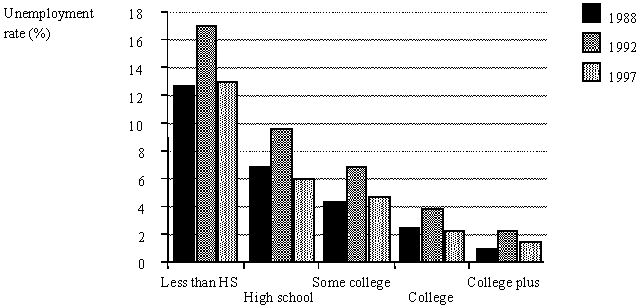
Figure 1 illustrates three points. First, in recession and economic expansion alike, the unemployment rate is higher for workers with lower educational attainment. In 1997, women and men with less than high school faced an unemployment rate of 13 to 14 percent. In contrast, the unemployment rate was 5.5 to 6 percent for high school graduates, 4 to 5 percent for men and women with some college, about 2.2 percent for college graduates, and less than 2 percent for those with more than four years of college. Even in good times, then, the labor market prospects of workers who have not completed high school are relatively bleak.
Second, for all groups except the most highly educated women, the unemployment rate rose sharply in the last recession (as shown by the increases between 1988 and 1992).
Third, although by 1997 the unemployment rate had returned to its pre-recession level (or nearly so) for other groups of workers, the unemployment rate for women with less than high school actually increased in the post-recession period. That is, the unemployment rate for women with less than a high school education remained high (and even increased somewhat) as the economic upswing of the 1990s progressed. This is the main finding in figure 1 that needs to be explained, since it raises an important concern for efforts to move former welfare recipients into the labor force.
Explanations
Why did the unemployment rate for women with less than high school not fall during the current recovery? Three factors appear to be at work.
Declining Demand for Low-Skilled Labor. First, it is widely believed that the demand for low-skilled workers in the United States has been falling over time, mainly as a result of skill-biased technological change (see, for example, Mark 1987; Bound and Johnson 1992, 1995). By itself, the decrease in demand for low-skilled women would reduce employment and put downward pressure on the wages. In the presence of an effective minimum wage, such a drop in demand would lead to increased unemployment.
Rising Labor Force Participation. An important trend on the supply side of the labor market for low-skilled women is apparent in figure 2: The number of women with less than high school who are seeking jobs has been on the rise. In particular, the labor force participation rate for women with less than high school increased between 1992 and 1997 from about 31.5 percent to 34 percent. [The labor force participation rate is defined as the sum of employment and unemployment (the labor force) as a percentage of all noninstitutionalized workers ages 16 and over (the population that is eligible to participate in the labor force).]
Figure 2a. Labor force participation rate for women by education, 1988, 1992, 1997.

Figure 2b. Labor force participation rate for men by education, 1988, 1992, 1997.
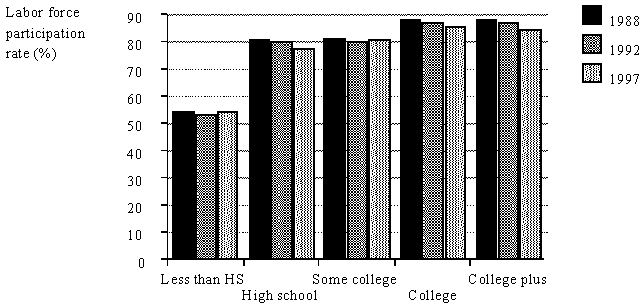
The increase in labor force participation of women with less than high school may have occurred in part because of anticipated changes in Aid to Families with Dependent Children (AFDC). Anecdotal reports from welfare caseworkers suggest that many welfare recipients reentered the labor force even before Temporary Assistance for Needy Families (TANF) became law.(1) In any case, increased labor force participation is exactly what can be expected as a result of TANF.(2) If what occurred between 1992 and 1997 is a precursor to what can be expected as TANF proceeds, then we can expect further increases in the labor force participation rate for women with less than high-school. If such a trend does develop, then the supply of low-skilled workers competing for jobs would increase, and the employment prospects for low-skilled former welfare recipients would worsen at least in the short run.
Fewer Women with High School or Less. A third trend is acting to blunt the two factors just discussed and to improve the labor market for low-skilled women. Specifically, the population of women with high school only or less than high school has fallen sharply since 1988. This can be seen in figure 3, which shows the population of women and men in each of the five educational categories examined for 1988, 1992, and 1997. (Population is defined as the sum of employed workers, unemployed workers, and noninstitutionalized individuals over age 16.) Whereas the number of women with some college and college degrees has risen rapidly since 1988, the number of women with less than high school has fallen by nearly 13 percent, and the number of women with only high school has fallen by 10 percent. This shift in the composition of the population from less to more education and skill should reduce the supply of low-skilled labor and put upward pressure on the wages of low-skilled women. In other words, the reduced supply of women with less than high school and high school only should, by itself, improve the labor market situation of the women who remain in the low-skilled labor market.
Figure 3a. Population of women by education, 1988, 1992, 1997.

Figure 3b. Population of men by education, 1988, 1992, 1997.
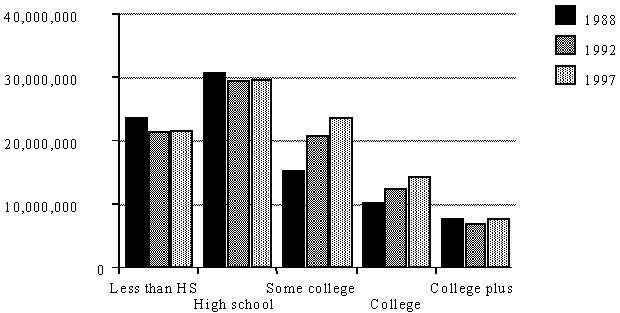
Clearly, though, the first two factors — declining demand for low-skilled labor and increasing labor force participation rates of low-skilled women — have dominated the labor market for low-skilled women. As a result, the unemployment rate of low-skilled women has been on the rise.
All three factors apply to men as well, but men's unemployment rates fell after the recession. The difference probably reflects the fact that women's opportunities are more restricted than men's and that opportunities for women are segregated from those for men.
Long-Term Trends versus the Business Cycle
The failure of the unemployment rate for women with less than high school to fall during the current recovery suggests that long-term or secular factors (such as technological change and trends in labor force participation) are more important than the business cycle in determining the employment status of low-skilled women. This suggestion is supported by what happened to the unemployment rate for low-skilled women during the recession of the early 1990s. As with most groups of workers, the unemployment rates for women with less than high school and high school only increased during the last recession. But in percentage terms, the increase in the unemployment rate for women who had a high school education or less was actually less severe than for women with more than high school (except for those with schooling beyond a college degree).(3) This does not imply that the last recession was in any sense kind to workers with high school or less, but it does suggest that, in relative terms, the recession of the early 1990s was not as hard on workers with less education (and was harder on workers with greater education) than earlier recessions had been. A likely explanation is that the secularly falling population of women with high school or less blunted what would otherwise have been a more substantial increase in the unemployment of low-skilled women. Whether this scenario — in which the employment of women with high school or less turns out to be less volatile than the employment of women with more education — would repeat itself in a future recession is an open question.
Summary
The labor market prospects for former welfare recipients are far less promising than for more-skilled groups of workers. First, in both good times and bad, workers with high school or less face substantially worse labor market prospects than workers with more schooling. Second, there is a consensus among labor economists that the demand for low-skilled labor is in long-run decline, mainly as a result of technological change. This falling demand can be expected to increase the unemployment of low-skilled labor relative to other workers. Third, it appears that the labor force participation rate for women with less than high school has been rising and can be expected to continue rising as TANF proceeds. This rising labor force participation rate implies a growing number of low-skilled job seekers. Both the second and third factors push in the direction of a higher unemployment rate for low-skilled workers. The one bright spot for former welfare recipients is that the population of women with high school or less than high school is falling, as the composition of the labor force shifts toward more educated workers. As a result, a smaller population of workers will be available to compete for the low-skilled jobs that workers with only high school or less typically occupy. Clearly, this does not eliminate the need to anticipate the next recession and to contemplate measures to create jobs for these workers, but it may make the problem less severe than it might otherwise be.
Low-Wage Jobs
In this section, low-wage jobs themselves are examined. How many low-wage and near low-wage jobs are there? What are the low-wage occupations? What happened to the number of these jobs over the last business cycle?
In order to address these questions, it is useful to focus on workers in hourly employment. This is reasonable because most welfare recipients who enter the labor market will be seeking a job that pays an hourly wage. Also, the Current Population Survey provides data on the hourly earnings of one-quarter of the workers in the CPS sample (see the data appendix for details).
Low-wage jobs are defined by using the September 1997 minimum wage, which was $5.15 an hour. That wage is then adjusted by the Consumer Price Index (CPI-U) to obtain a cut-off point of $4.48 for 1992 (slightly above the 1992 minimum wage of $4.25), and $3.75 for 1988 (when the minimum wage was $3.35 an hour).
To define near low-wage jobs, a somewhat arbitrary cutoff of $7.50 an hour for 1997 is used. Thus, near low-wage jobs for 1997 are defined as jobs that paid between $5.15 and $7.50 an hour. The $7.50 an hour cutoff is then adjusted by the CPI-U to obtain a near low-wage range of $4.48 to $6.53 an hour for 1992, and $3.75 to $5.46 an hour for 1988.
How Many Low-Wage Jobs Are There?
Figure 4 gives a general picture of hourly paid jobs over the last recession and recovery. The total number of hourly jobs shows a typical cyclical pattern: there was slow growth from 58.1 million in 1988 to 60.6 million in 1992 (or about 4 percent), then rapid growth during the recovery to 69.1 million in 1997 (about 14 percent).
Figure 4. Hourly paid jobs, total and by wage level.
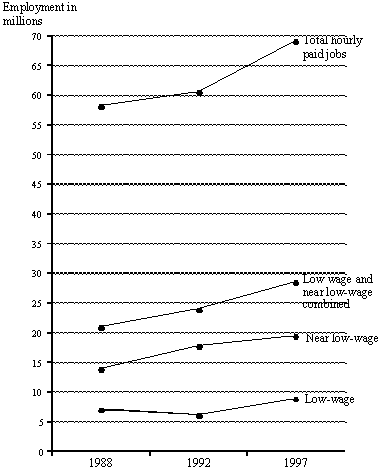
In contrast, the growth of hourly jobs at or near the minimum wage was more steady: low-wage and near low-wage jobs combined grew from 21 million in 1988 to 24 million in 1992 (or 14 percent), and then to 28.5 million in 1997 (or 18.6 percent).
However, the patterns for low-wage and near low-wage jobs differ significantly from each other. Low-wage jobs took a large hit during the last recession, falling from 7.1 million in 1988 to 6.2 million in 1992. They then recovered to 8.9 million in 1997. Near low-wage jobs, however, showed signs of being counter- cyclical, growing rapidly from 13.9 million in 1988 to 17.8 million in 1992 (or 28 percent), then growing more slowly during the recovery to 19.5 million in 1997 (or 9.6 percent).
The cyclical pattern shown by low-wage jobs is expected. Both human capital theory and empirical evidence suggest that low-wage, low-skilled workers are more likely to be laid off in a recession than are high-wage, skilled workers. In contrast, it appears that near low-wage jobs are sufficiently skilled (and filled by workers who are sufficiently skilled) that employers maintain the jobs through a recession, rather than eliminating the jobs and laying off the workers.
Mainly, the data in figure 4 make it clear that the number of low-wage jobs (that is, jobs earning roughly minimum wage) fell significantly during the last recession. Such a drop can be expected to repeat itself in the next recession.
Occupational Mix of Low-Wage Jobs
Figure 5 shows a breakdown of low-wage and near low-wage jobs by occupation. Three conclusions are clear from figure 5. First, low-wage and near low-wage jobs combined are concentrated in service, sales, and clerical occupations, followed by labor (a catchall category for low-skilled labor), and operative jobs (that is, jobs that involve tending or operating a machine). The largest of these — service and sales occupations — have been rapidly growing segments of the labor market.
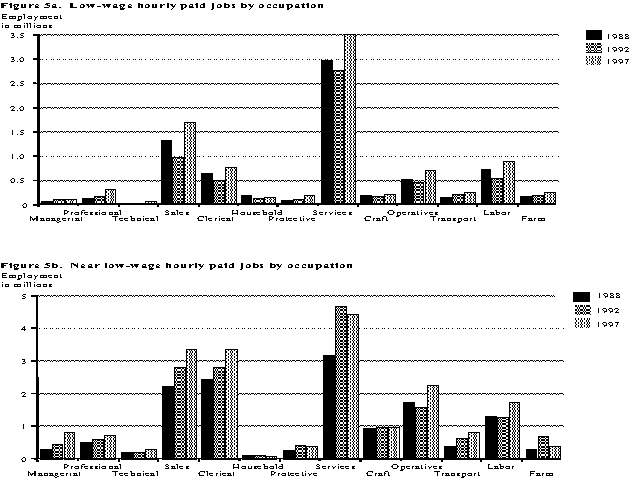
Second, low-wage jobs in occupations where they are concentrated tend to show the same pattern through the last business cycle: a loss of jobs between 1988 and 1992 followed by recovery between 1992 and 1997. This is the same cyclical pattern that can be seen for low-wage jobs overall in figure 4.
Third, near low-wage jobs in occupations where they are concentrated show a somewhat different pattern: an increase in employment between 1988 and 1992 (except among operatives and laborers) followed by further increases (or, in services, a modest drop) between 1992 and 1997. This reflects the somewhat counter cyclical pattern that can be seen for near low-wage jobs overall in figure 4. It follows that most of the occupational segments of the near low-wage labor markets follow aggregate movements in near low-wage jobs.
Regional Differences in Jobs and Unemployment Rates
There has been concern that former welfare recipients will have greater difficulty finding jobs in some regions than in others. In light of this concern, it is important to ask how low-wage labor markets vary by region. In this section, regional differences over the past decade are examined using three labor market indicators:
- The growth of paid jobs;
- The mix of low-wage, near low-wage, and higher-wage jobs; and
- The unemployment rate facing women with high school only or less than high school.
Figure 6 displays data on the first two of these indicators. The job prospects of former welfare recipients depend both on the overall growth of jobs in a regional economy and on the mix of low-wage, near low-wage, and higher-wage jobs in a region. Where overall job growth is good, and where the mix of jobs is shifting toward higher-wage jobs, labor markets tend to be tighter. In such labor markets, former welfare recipients are likely to face good job prospects and opportunities to upgrade their skills and to qualify for jobs that pay well above the minimum wage.
Figure 6. Hourly paid jobs by wage level and region, 1988, 1992, 1997.
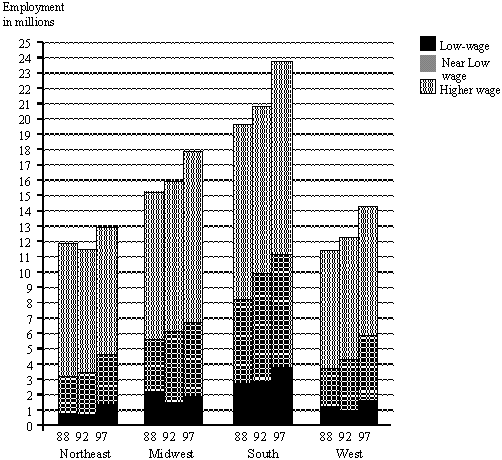
Figure 7 displays data on the third indicator — the unemployment rate for women with high school only or less than high school in each major region. These unemployment rates should be related inversely to the employment prospects of former welfare recipients in each region.
Figure 7. Unemployment rate for women with high school or less by region, 1988, 1992, 1997.

The data in figures 6 and 7 are used to examine the job prospects of former welfare recipients in each of the four major regions of the United States.
Slack Labor Markets in the Northeast
In the Northeast, the total number of hourly jobs grew only modestly between 1988 and 1997 — by less than 9 percent (see figure 6), compared with nearly 19 percent nationally. Also, the mix of hourly jobs shifted toward low-wage and near low-wage jobs — whereas low-wage and near low-wage jobs accounted for about 28 percent of all hourly jobs in 1988, they were 36 percent of all hourly jobs by 1997. The growth of low-wage jobs in the Northeast was especially strong following the recession of the early 1990s. Relatively slow job growth and the shift toward lower-paying jobs suggest that labor markets in the Northeast are relatively slack.
A look at the unemployment rate for women with high school or less tends to confirm the view that the labor market is slack in the Northeast. Figure 7 shows that the unemployment rate for women with high school or less rose dramatically in the Northeast during the last recession (that is, between 1988 and 1992). Moreover, the Northeast has struggled to recover since 1992: The 1997 unemployment rate for women with high school or less was 7 percent, well above its pre-recession (1988) level.
Tight Labor Markets in the Midwest
In the Midwest, the total number of hourly jobs grew by 18 percent between 1988 and 1997, roughly the national average (see figure 6). In the Midwest, low-wage and near low-wage jobs together accounted for 37 percent of all hourly jobs in both 1988 and 1997. However, the mix of low-wage and near low-wage jobs shifted: The number of low-wage jobs fell while the number of near low-wage jobs grew rapidly (by over 36 percent). Good job growth and the shift toward higher-paying jobs suggest that labor markets in the Midwest are relatively tight.
As can be seen in figure 7, the Midwest experienced only a mild recession in the early 1990s: The unemployment rate for women with high school or less barely budged between 1988 and 1992. Moreover, the unemployment rate for women with high school or less fell significantly between 1992 and 1997, and stood at just under 6 percent in 1997. The evidence is strong that labor markets in the Midwest are tight and favorable for former welfare recipients to both enter the job market and move up to better jobs.
A Shift Toward Low-Wage Jobs in the South
In the South, the total number of hourly jobs grew at just below the national average between 1988 and 1997 — by 16 percent (see figure 6). However, in the South, the mix of hourly jobs shifted toward low-wage and near low-wage jobs. While low-wage and near low-wage jobs accounted for 42 percent of all hourly jobs in 1988, they were 49 percent of all hourly jobs by 1997. (Low-wage and near low-wage jobs grew at about the same rate.) Overall job growth in the South has been good, but the shift toward low-paying jobs suggests that labor markets in the South are weaker than those in the Midwest, with fewer options for moving into better jobs.
Like the Midwest, the South experienced only a mild recession in the early 1990s, and the unemployment rate for women with high school or less barely rose between 1988 and 1992 (see figure 7). In the South, though, the unemployment rate for women with high school or less fell very little following the recession and stood at about 8.4 percent in 1997.
Overall, the data in figures 6 and 7 suggest that, although jobs in the South have grown at roughly the national average rate, the pace of job growth in the South has not been enough to keep up with the number of new job seekers. In other words, labor markets in the South appear to be rather slack.
High Unemployment in the West
Of the four major regions, the West had the strongest growth of hourly jobs overall between 1988 and 1997 — the total number of hourly jobs grew by over 26 percent (see figure 6). However, a disproportionate amount of this growth was concentrated in low-wage and near low-wage jobs. Whereas low-wage and near low-wage jobs accounted for 33 percent of all hourly jobs in 1988, they were 41 percent of all hourly jobs by 1997. That is, job growth in the West has been good, but there has been a strong shift toward low-paying jobs, suggesting slack in the labor market.
Like the Northeast, the West experienced a severe recession in the early 1990s. This is reflected in the dramatic rise in the unemployment rate for women with high school or less between 1998 and 1992 (see figure 7). Also like the Northeast, the West has struggled to recover since 1992, and the 1997 unemployment rate for women with high school or less was nearly 9 percent — the highest of any region and well above the pre-recession level.
Summary
Of the four major regions of the United States, only the Midwest has a labor market that could be characterized as highly favorable to former welfare recipients. In the Midwest, hourly job growth has been rapid, the mix of jobs has shifted toward higher-paying jobs (suggesting growing demand for labor), and the unemployment rate has dropped to a level well below that preceding the recession of the early 1990s.
In the other three major regions, while former welfare recipients may find jobs, many may face difficulties in remaining employed and moving up in the job market. In the Northeast, job growth has been slow and skewed toward low-wage jobs, and the 1997 unemployment rate for women with high school or less was still above its 1988 level. In the South, job growth has also been skewed toward low-wage jobs, and, there, too, the unemployment rate for women with high school or less has been persistently high — almost 8.5 percent in 1997. In the West, job growth has been concentrated in low-wage jobs, and the unemployment rate for women with high school or less, although it has fallen from over 10 percent in 1992, was still nearly 9 percent in 1997.
Differences in Jobs and Unemployment Rates by Urban Location
There has also been concern that, as a result of locational mismatches, former welfare recipients in central cities will have greater difficulty in making the transition to work than will former welfare recipients in suburbs and nonurban areas. A complete examination of this issue would require a careful look at the location of current welfare recipients and the corresponding location of low-wage and near low-wage jobs. Although such an examination is beyond the scope of this paper, in this section the variation in low-wage labor markets among central cities, suburbs, and nonurban areas are examined using the same three labor market indicators examined in section 3 above:
- The growth of hourly paid jobs,
- The mix of jobs, and
- The unemployment rate facing women with high school or less.
Figure 8 displays data on the first two of these indicators. As noted at the beginning of the third section, the job prospects for former welfare recipients depend both on the overall growth of jobs in an area and on the mix of low-wage, near low-wage, and higher-wage jobs in an area. Figure 9 shows data on the third indicator, the unemployment rate for women with high school or less in each urban location. The data in figures 8 and 9 are used to examine the job prospects for welfare recipients in central cities, urban areas outside central cities, and non-urban areas.
Figure 8. Hourly paid jobs by wage level and urban location, 19988, 1992, and 1997.
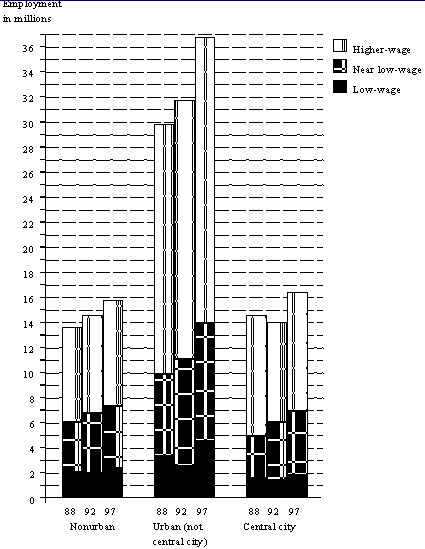
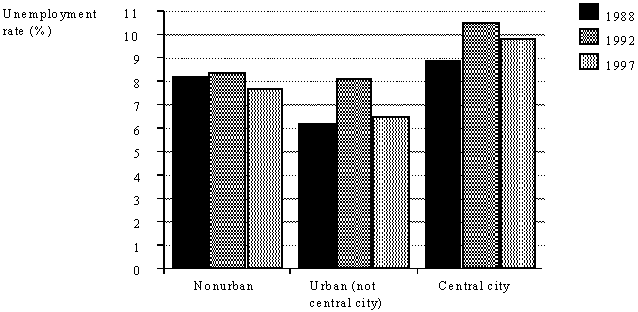
Slack in Central Cities
Figure 8 shows that, between 1988 and 1997, hourly job growth in central cities was about 13 percent — below the growth of jobs in either the suburbs (urban areas that are not within a central city) or non-urban areas. Also, although the mix of hourly jobs shifted toward low-wage and near low-wage jobs in all three locations, the shift was most pronounced in central cities, where low-wage and near low-wage jobs accounted for 34.4 percent of all hourly jobs in 1988, and grew to 42.6 percent of all hourly jobs by 1997. The relatively slow overall job growth and the strong shift toward low-wage and near low-wage jobs both suggest that labor markets in central cities are slack. It follows that the job prospects for former welfare recipients are relatively weak in central cities, where welfare recipients are disproportionately located
A look at the unemployment rate for women with high school or less in central cities tends to confirm that the job prospects for former welfare recipients in central cities are relatively bleak. Figure 9 shows that the unemployment rate for women with high school or less rose more in central cities than elsewhere during the last recession (that is, between 1988 and 1992). Moreover, during the recovery the unemployment rate for women with high school or less has fallen less in the central cities than elsewhere. In short, concerns that former welfare recipients face greater labor market difficulties in central cities than in other locations seem well justified.
Tight Suburban Labor Markets
In contrast to central cities, suburbs (urban areas that are not within a central city) had strong hourly job growth between 1988 and 1997. Figure 8 shows that, between 1988 and 1997, hourly job growth was over 23 percent in suburbs. In addition, the mix of hourly jobs shifted less toward low-wage and near low-wage jobs in suburbs than in central cities: In the suburbs, low-wage and near low-wage jobs grew from 33 percent to 38 percent of all hourly jobs. Both of these factors suggest that suburban labor markets are relatively tight.
The suburban unemployment rate for women with high school or less also suggests a relatively favorable employment outlook in the suburbs. Although the unemployment rate for women with high school or less rose to slightly over 8 percent in 1992, it had fallen to 6.5 percent by 1997 — lower than in either central cities or non-urban areas (see figure 9).
A Mixed Picture in Non-urban Labor Markets
In non-urban areas, hourly job growth between 1988 and 1997 was 15.5 percent — in between the growth of hourly jobs in central cities and suburbs (see figure 8). Also, the shift of hourly jobs toward low-wage and near low-wage jobs was less pronounced in non-urban areas than elsewhere; in non-urban areas, low-wage and near low-wage jobs grew from 44 percent to 47 percent of all hourly jobs. These factors suggest a relatively favorable outlook for former welfare recipients in non-urban areas.
Nonetheless, the proportion of low or near low-wage work remains quite high in non-urban areas. Furthermore, the unemployment rate in non-urban areas for women with high school or less has been persistently higher than in suburbs. That rate was above 8 percent in both 1988 and 1992, and fell by less than one point, to 7.7 percent, by 1997 (see figure 9).
Summary
Overall, the job prospects for former welfare recipients appear to be weakest in central cities and strongest in the suburbs. The outlook in central cities is clouded by slow overall job growth, a strong shift toward low-wage jobs, and a high unemployment rate. These are potentially troubling trends, given the relative concentration of former welfare recipients in central cities.
Main Findings and Policy Implications
The main findings of the first two sections can be summarized in three points:
- First, in good times and bad times alike, women with high school only or less than high school have far higher unemployment rates than women with more education.
- Second, the labor market for low-wage workers has not improved in concert with the improving opportunities for high-skilled workers during the economic recovery of the 1990s. In particular, the unemployment rate of women with less than high school has remained at roughly the level it reached during the last recession.
- Third, the number of low-wage jobs is highly cyclical, falling disproportionately during the recession of the early 1990s.
In short, former welfare recipients face formidable barriers in making the transition to employment. The main reasons for the problems facing low-wage workers are long-term rather than cyclical. There has been a long-term decline in the demand for low-skilled workers, and the labor force participation rate for women with high school or less has been rising secularly.
In the third and fourth sections, the differences in the labor market prospects of former welfare recipients were examined (a) across the four major regions of the United States and (b) among central cities, suburbs, and nonurban areas. Only the Midwest has a labor market that appears to be highly favorable to former welfare recipients. In the Northeast, South, and West, labor market indicators suggest that the job prospects for former welfare recipients are far less favorable. The job prospects of former welfare recipients in central cities are less favorable than in suburbs or nonurban areas. The implication is that efforts to find jobs for former welfare recipients will face greater difficulties in the central cities of the Northeast and West than in suburbs, nonurban areas, and the Midwest generally.
Overall, the trends discussed in this paper suggest that policymakers will need to anticipate the consequences of the next recession and consider measures to assist former welfare recipients when the inevitable downturn arrives. Efforts to upgrade the skills of former welfare recipients and to place them in jobs using various forms of job search assistance will, of course, be helpful. Ultimately, though, the findings suggest that weak demand for low-skilled labor is the greatest barrier facing former welfare recipients.
Data Appendix: The Current Population Survey
The figures presented in this paper were generated from tabulations of the March 1988, March 1992, and March 1997 Annual Demographic Files of the Current Population Survey (CPS). The CPS is a monthly survey of a sample of roughly 55,000 households nationwide. It provides information on the employment and unemployment status and other characteristics of the civilian population 16 years of age and older. In March, the CPS collects additional data from respondents in order to provide a more complete picture of each respondent's experience in the labor market (this is the Annual Demographic File). We created figures 1, 2, 3, 7, and 9 by tabulating the full CPS sample of individuals ages 16 and over who were not institutionalized or in the military. Appropriate sample weights were applied to the tabulations to arrive at the population estimates reported.
Each month, data on the hourly earnings of workers are collected from one-quarter of the CPS sample (see, for example, Mellor and Haugen 1986). The relevant questions are: (1) Is ____ paid by the hour on this job? (2) How much does ____ earn per hour?
Figures 4, 5, 6, and 8 were created by tabulating the one-quarter of the CPS sample who were questioned about their hourly earnings in March 1988, March 1992, and March 1997. Again, appropriate sample weights were applied to the tabulations to arrive at the population estimates reported. Because the population estimates underlying figures 4, 5, 6, and 8 are based on smaller samples than those underlying figures 1, 2, 3, 7, and 9, they have larger sampling errors associated with them.
References
Acs, Gregory, Norma Coe, Keith Watson, and Robert I. Lerman. 1998. "Does Work Pay? An Analysis of the Work Incentives under TANF." Assessing the New Federalism Occasional Paper Number 9. Washington, D.C.: The Urban Institute.
Bound, John, and George E. Johnson. 1992. "Changes in the Structure of Wages in the 1980s: An Evaluation of Alternative Explanations." American Economic Review 82 (June): 371-92.
Bound, John, and George E. Johnson. 1995. "What Are the Causes of Rising Wage Inequality in the United States?" Federal Reserve Bank of New York Economic Policy Review 1 (January): 9-17.
Gallagher, L. Jerome, Megan Gallagher, Kevin Perese, Susan Schreiber, and Keith Watson. 1998. "One Year after Federal Welfare Reform: A Description of State Temporary Assistance for Needy Families (TANF) Decisions as of October 1997." Assessing the New Federalism Occasional Paper Number 6. Washington, D.C.: The Urban Institute.
Mark, Jerome. 1987. "Technological Change and Employment: Some Results from BLS Research." Monthly Labor Review 110 (April): 26-9.
Mellor, Earl F., and Steven E. Haugen. 1986. "Hourly Paid Workers: Who They Are and What They Earn." Monthly Labor Review 109 (February): 20-6.
Footnotes
1. Gallagher et al. (1998).
2. Acs et al. (1998).
3. For women with less than high school, the unemployment rate rose by 16 percent; for women who were high school graduates, by 22 percent; for women with some college, by 50 percent; and for women with a college degree, by 25 percent. For men with less than high school, the unemployment rate rose by 34 percent; for men who were high school graduates, by 39 percent; for men with some college, by 56 percent; and for men with a college degree, by 57 percent.
